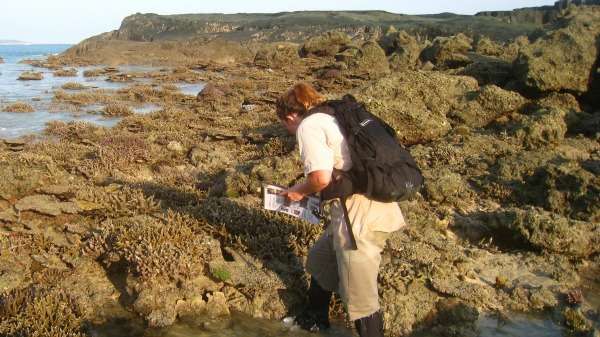Resilient Kimberley community provides new hope for coral reefs

The discovery of a highly diverse coral community in a harsh but untouched marine environment in the Kimberley has sparked new hope for the future of coral reefs and prompted scientists to rethink factors that promote coral reef survival.
WA Museum coral biodiversity researcher Zoe Richards and her colleagues examined corals in three island groups in the remote Bonaparte Archipelago and were stunned with what they found.
"This area experiences huge tidal oscillations of up to eight metres, which means that at low tide the fringing reef communities are exposed to intense tropical sunshine for up to 3.5 hours at a time, as well as wind, rain and extremes in UV light," Dr Richards says.
"My expectation was that there wouldn't be many types of coral living in the intertidal zone, simply because the environment would be too harsh.
"But what we found was that, despite the extreme conditions, a whole range of corals had adapted to not only survive, but thrive there."
Resident crocodiles prevented scuba diving surveys so Dr Richards and her team surveyed the coral community by traversing the reefs carefully on foot during the few hours they were exposed at low tide.
The resultant surveys uncovered at least 225 different types of coral from 23 intertidal sites, including seven newly recorded species for WA.
Absence of pollution could the key to survival
The discovery of such a thriving coral ecosystem in such a harsh environment begged the question of how the diverse Bonaparte community is being sustained when intertidal coral communities all around the world are in decline.
Dr Richards says that while the Bonaparte reefs face extreme environmental conditions, they are spared the impacts of pollution.
"Intertidal reefs occurring in locations closer to human populations appear to have succumbed to all the other stressors that are imposed upon them, such as pollution, unnatural sediment regimes, freshwater inundation, and predator outbreaks," she says.
"The Bonaparte intertidal community offers hope that if we are able to minimise these additional stressors, and make sensible choices about coastal development, corals may be able to recover and rehabilitate damaged reefs even in the face of climate change."
Dr Richards is now working towards understanding how these corals tolerate stress.
She considers it possible that the hardy Kimberley corals may have the edge over other coral species in a changing environment.
But she also acknowledges that if Kimberley corals were exposed to additional pollution impacts they may also succumb.
Provided by Science Network WA





















